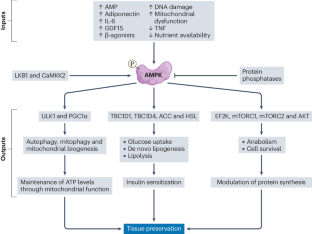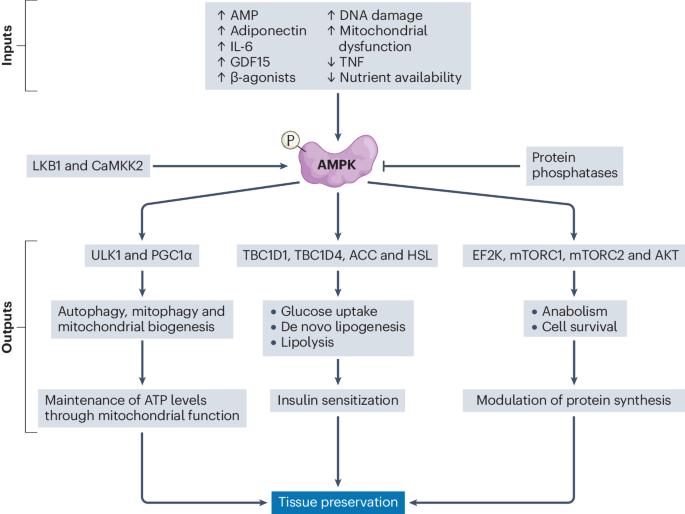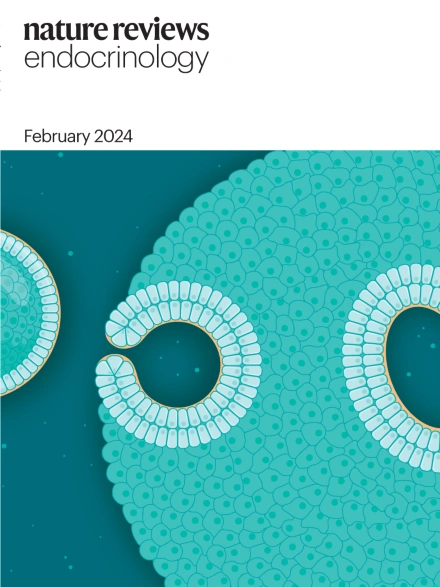AMPK as a mediator of tissue preservation: time for a shift in dogma?
IF 40
1区 医学
Q1 ENDOCRINOLOGY & METABOLISM
引用次数: 0
Abstract
Ground-breaking discoveries have established 5′-AMP-activated protein kinase (AMPK) as a central sensor of metabolic stress in cells and tissues. AMPK is activated through cellular starvation, exercise and drugs by either directly or indirectly affecting the intracellular AMP (or ADP) to ATP ratio. In turn, AMPK regulates multiple processes of cell metabolism, such as the maintenance of cellular ATP levels, via the regulation of fatty acid oxidation, glucose uptake, glycolysis, autophagy, mitochondrial biogenesis and degradation, and insulin sensitivity. Moreover, AMPK inhibits anabolic processes, such as lipogenesis and protein synthesis. These findings support the notion that AMPK is a crucial regulator of cell catabolism. However, studies have revealed that AMPK’s role in cell homeostasis might not be as unidirectional as originally thought. This Review explores emerging evidence for AMPK as a promoter of cell survival and an enhancer of anabolic capacity in skeletal muscle and adipose tissue during catabolic crises. We discuss AMPK-activating interventions for tissue preservation during tissue wasting in cancer-associated cachexia and explore the clinical potential of AMPK activation in wasting conditions. Overall, we provide arguments that call for a shift in the current dogma of AMPK as a mere regulator of cell catabolism, concluding that AMPK has an unexpected role in tissue preservation. This Review discusses the role of AMPK in cancer cachexia and metabolic dysfunction, including discussion of how targeting AMPK might be an option to preserve muscle and adipose tissue mass.


作为组织保存介质的 AMPK:转变教条的时候到了吗?
突破性研究发现,5′-AMP-活化蛋白激酶(AMPK)是细胞和组织代谢压力的核心传感器。AMPK 通过直接或间接影响细胞内 AMP(或 ADP)与 ATP 的比率,在细胞饥饿、运动和药物作用下被激活。反过来,AMPK 又通过调节脂肪酸氧化、葡萄糖摄取、糖酵解、自噬、线粒体生物生成和降解以及胰岛素敏感性来调节细胞代谢的多个过程,如维持细胞 ATP 水平。此外,AMPK 还能抑制脂肪生成和蛋白质合成等合成代谢过程。这些发现支持了 AMPK 是细胞分解代谢的关键调节因子这一观点。然而,研究发现,AMPK 在细胞稳态中的作用可能不像最初认为的那样是单向的。本综述探讨了 AMPK 在分解代谢危机期间促进细胞存活并增强骨骼肌和脂肪组织合成代谢能力的新证据。我们讨论了在癌症相关恶病质的组织消瘦过程中为保护组织而采取的激活 AMPK 的干预措施,并探讨了在消瘦情况下激活 AMPK 的临床潜力。总之,我们提出了一些论点,要求改变目前认为 AMPK 只是细胞分解代谢调节器的教条,并得出结论:AMPK 在组织保存方面具有意想不到的作用。
本文章由计算机程序翻译,如有差异,请以英文原文为准。
求助全文
约1分钟内获得全文
求助全文
来源期刊

Nature Reviews Endocrinology
医学-内分泌学与代谢
CiteScore
42.00
自引率
0.70%
发文量
158
审稿时长
6-12 weeks
期刊介绍:
Nature Reviews Endocrinology aspires to be the foremost platform for reviews and commentaries catering to the scientific communities it serves. The journal aims to publish articles characterized by authority, accessibility, and clarity, enhanced with easily understandable figures, tables, and other visual aids. The goal is to offer an unparalleled service to authors, referees, and readers, striving to maximize the usefulness and impact of each article. Nature Reviews Endocrinology publishes Research Highlights, Comments, News & Views, Reviews, Consensus Statements, and Perspectives relevant to researchers and clinicians in the fields of endocrinology and metabolism. Its broad scope ensures that the work it publishes reaches the widest possible audience.
 求助内容:
求助内容: 应助结果提醒方式:
应助结果提醒方式:


